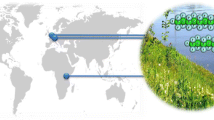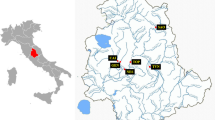Abstract
In this study, the concentrations of 13 perfluorinated compounds (PFCs) (PFBuS, PFHxS, PFOS, THPFOS, PFHxA, PFHpA, PFOA, PFNA, PFDA, PFUnDA, PFDoDA, PFTDA, and PFOSA) were analyzed in municipal drinking water samples collected at 40 different locations from 5 different zones of Catalonia, Spain. Detection limits ranged between 0.02 (PFHxS) and 0.85 ng/L (PFOA). The most frequent compounds were PFOS and PFHxS, which were detected in 35 and 31 samples, with maximum concentrations of 58.1 and 5.30 ng/L, respectively. PFBuS, PFHxA, and PFOA were also frequently detected (29, 27, and 26 samples, respectively), with maximum levels of 69.4, 8.55, and 57.4 ng/L. In contrast, PFDoDA and PFTDA could not be detected in any sample. The most contaminated water samples were found in the Barcelona Province, whereas none of the analyzed PFCs could be detected in two samples (Banyoles and Lleida), and only one PFC could be detected in four of the samples. Assuming a human water consumption of 2 L/day, the maximum daily intake of PFOS and PFOA from municipal drinking water would be, for a subject of 70 kg of body weight, 1.7 and 1.6 ng/kg/day. This is clearly lower than the respective Tolerable Daily Intake set by the European Food Safety Authority. In all samples, PFOS and PFOA also showed lower levels than the short-term provisional health advisory limit for drinking water (200 ng PFOS/L and 400 ng PFOA/L) set by the US Environmental Protection Agency. Although PFOS and PFOA concentrations found in drinking water in Catalonia are not expected to pose human health risks, safety limits for exposure to the remaining PFCs are clearly necessary, as health-based drinking water concentration protective for lifetime exposure is set to 40 ng/L for PFOA.



Similar content being viewed by others
References
3M (2001) Environmental monitoring—multi-city study, water, sludge, sediment, POTW effluent and landfill leachate samples. Executive summary, 3M Environmental Laboratory, St Paul, MN, June 25, 2001. Available from http://www.ewg.org/files/multicity_full.pdf. Accessed 20 July 2009
Conder JM, Hoke RA, De Wolf W, Russell MH, Buck RC (2008) Are PFCAs bioaccumulative? A critical review and comparison with regulatory criteria and persistent lipophilic compounds. Environ Sci Technol 42:995–1003
EFSA (European Food Safety Authority) (2008) Perfluorooctane sulfonate (PFOS), perfluorooctanoic acid (PFOA) and their salts. EFSA J 653:1–131
Ericson I, Gómez M, Nadal M, van Bavel B, Lindström G, Domingo JL (2007) Perfluorinated chemicals in blood of residents in Catalonia (Spain) in relation to age and gender: a pilot study. Environ Int 33:616–623
Ericson I, Martí-Cid R, Nadal M, Van Bavel B, Lindström G, Domingo JL (2008a) Human exposure to perfluorinated chemicals through the diet: intake of perfluorinated compounds in foods from the Catalan (Spain) market. J Agric Food Chem 56:1787–1794
Ericson I, Nadal M, van Bavel B, Lindström G, Domingo JL (2008b) Levels of perfluorochemicals in water samples from Catalonia, Spain: is drinking water a significant contribution to human exposure? Environ Sci Pollut Res 15:614–619
Fromme H, Tittlemier SA, Völkel W, Wilhelm M, Twardella D (2009) Perfluorinated compounds: exposure assessment for the general population in western countries. Int J Hyg Environ Health 212:239–270
Gulkowska A, Jiang Q, So MK, Taniyasu S, Lam PK, Yamashita N (2006) Persistent perfluorinated acids in seafood collected from two cities of China. Environ Sci Technol 40:3736–3741
Hansen KJ, Johnson HO, Eldridge JS, Butenhoff JL, Dick LA (2002) Quantitative characterization of trace levels of PFOS and PFOA in the Tennessee River. Environ Sci Technol 36:1681–1685
Hart K, Gill VA, Kannan K (2009) Temporal trends (1992–2007) of perfluorinated chemicals in Northern Sea otters (Enhydra lutris kenyoni) from South-Central Alaska. Arch Environ Contam Toxicol 56:607–614
Hölzer J, Midasch O, Rauchfuss K, Kraft M, Reupert R, Angerer J, Kleeschulte P, Marschall N, Wilhelm M (2008) Biomonitoring of perfluorinated compounds in children and adults exposed to perfluorooctanoate-contaminated drinking water. Environ Health Perspect 116:651–657
Kannan K, Tao L, Sinclair E, Pastva SD, Jude DJ, Giesy JP (2005) Perfluorinated compounds in aquatic organisms at various trophic levels in a Great Lakes food chain. Arch Environ Contam Toxicol 48:559–566
Lange FT, Wenz M, Schmidt CK, Brauch HJ (2007) Occurrence of perfluoroalkyl sulfonates and carboxylates in German drinking water sources compared to other countries. Water Sci Technol 56:151–158
OECD (2002) Hazard assessment of perfluorooctane sulfonate (PFOS) and its salts. Co-operation on existing chemicals. Organization for Economic Co-operation and Development (OECD), ENV/JM/RD (2002) 17/FINAL. November 21 2002
Post GB, Louis JB, Cooper KR, Boros-Russo BJ, Lippincott RL (2009) Occurrence and potential significance of perfluorooctanoic acid (PFOA) detected in New Jersey public drinking water systems. Environ Sci Technol 43:4547–4554
Saito N, Harada K, Inoue K, Sasaki K, Yoshinaga T, Koizumi A (2004) Perfluorooctanoate and perfluorooctane sulfonate concentrations in surface water in Japan. J Occup Health 46:49–59
Sinclair E, Mayack DT, Roblee K, Yamashita N, Kannan K (2006) Occurrence of perfluoroalkyl surfactants in water, fish, and birds from New York State. Arch Environ Contam Toxicol 50:398–410
Stahl T, Heyn J, Thiele H, Hüther J, Failing K, Georgii S, Brunn H (2009) Carryover of perfluorooctanoic acid (PFOA) and perfluorooctane sulfonate (PFOS) from soil to plants. Arch Environ Contam Toxicol 57:289–298
Skutlarek D, Exner M, Färber H (2006) Perfluorinated surfactants in surface and drinking waters. Environ Sci Pollut Res 13:299–307
Takagi S, Adachi F, Miyano K, Koizumi Y, Tanaka H, Mimura M, Watanabe I, Tanabe S, Kannan K (2008) Perfluorooctanesulfonate and perfluorooctanoate in raw and treated tap water from Osaka, Japan. Chemosphere 72:1409–1412
Tanaka S, Fujii S, Lien NPH, Nozoe M, Chinagarn K, Kimura K, Shivakoti B, Anton A, Maketab M, Wirojanagud W, Hu JY, Kitpati S, Shimizu J, Tittlemier S, Lindström G, Saito N (2008) Contamination of perfluorinated compounds in water environment of Asian countries. Organohalogen Compd 70:402–405
Trudel D, Horowitz L, Wormuth M, Scheringer M, Cousins IT, Hungerbühler K (2008) Estimating consumer exposure to PFOS and PFOA. Risk Anal 28:251–269
USEPA (2009) Provisional health advisories for perfluorooctanoic acid (PFOA) and perfluorooctane sulfonate (PFOS). Office of Water. US Environmental Protection Agency. Washington, DC. Available from http://www.epa.gov/waterscience/criteria/drinking/pha-PFOA_PFOS.pdf. Accessed 20 July 2009
van Leeuwen SP, Karrman A, van Bavel B, de Boer J, Lindstrom G (2006) Struggle for quality in determination of perfluorinated contaminants in environmental and human samples. Environ Sci Technol 40:7854–7860
Wilhelm M, Kraft M, Rauchfuss K, Hölzer J (2008) Assessment and management of the first German case of a contamination with perfluorinated compounds (PFC) in the Region Sauerland, North Rhine-Westphalia. J Toxicol Environ Health A 71:725–733
Wold S, Dunn WJIII, Hellberg S (1985) Toxicity modelling and prediction with pattern recognition. Environ Health Perspect 61:257–268
Yeung LW, Loi EI, Wong VY, Guruge KS, Yamanaka N, Tanimura N, Hasegawa J, Yamashita N, Miyazaki S, Lam PK (2009) Biochemical responses and accumulation properties of long-chain perfluorinated compounds (PFOS/PFDA/PFOA) in juvenile chickens (Gallus gallus). Arch Environ Contam Toxicol 57:377–386
Acknowledgment
This study was financially supported by the Catalan Public Health Agency, Department of Health, Generalitat de Catalunya, Barcelona, Catalonia, Spain.
Author information
Authors and Affiliations
Corresponding author
Rights and permissions
About this article
Cite this article
Ericson, I., Domingo, J.L., Nadal, M. et al. Levels of Perfluorinated Chemicals in Municipal Drinking Water from Catalonia, Spain: Public Health Implications. Arch Environ Contam Toxicol 57, 631–638 (2009). https://doi.org/10.1007/s00244-009-9375-y
Received:
Accepted:
Published:
Issue Date:
DOI: https://doi.org/10.1007/s00244-009-9375-y




